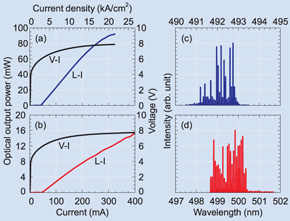
| Home | About Us | Contribute | Bookstore | Advertising | Subscribe for Free NOW! |
| News Archive | Features | Events | Recruitment | Directory |
| FREE subscription |
| Subscribe for free to receive each issue of Semiconductor Today magazine and weekly news brief. |
News
23 February 2009
Non-polar InGaN lasers near green light
Scientists at Rohm Co Ltd’s R&D headquarters in Kyoto, Japan have extended the wavelength for continuous wave (CW) operation of indium gallium nitride (InGaN) laser diodes (LDs) [Okamoto et al, App. Phys. Lett., vol.94, p.071105, 2009]. The researchers claim that the 499.8nm (near-green) CW lasing wavelength is the longest reported for such devices. Previously, Rohm reported a 481nm blue-green laser last June followed by a 488nm laser in October, while Nichia had reported a 488nm blue-green laser in January 2008. Among the possible applications of laser diodes emitting at green wavelengths (i.e. 490–560nm) , when commercialized, could be full-color displays and mobile projectors.
The Rohm team grew the laser diodes on free-standing m-plane wurzite GaN substrates (supplied by Mitsubishi Chemical) using low-pressure metal-organic chemical vapor deposition (MOCVD). By growing in the m-plane direction, rather than the more usual c-plane, the devices avoid the large polarization electric fields that arise from the different effective charges (ionicity) of the group III elements (Ga, Al, In) and nitrogen in the wurzite lattice. Such large polarization fields shift the energy band levels of the carriers in heterostructures through quantum-confined Stark effects (QCSEs). Such fields also make it difficult to set up the electrical conditions needed for lasing.
The Rohm laser diode structures consisted of a sequence of layers of n-type GaN, n-type AlGaN (cladding), n-type InGaN (waveguide), a two-period InGaN multi-quantum well (active), p-type AlGaN (electron blocking), p-type InGaN (waveguide), p-type AlGaN (cladding), and p-type GaN (contact). Ridged stripes were etched out to form the laser structures (bottom width: 2.5 microns). A ZrO2 insulator was used. The cavities were 600 microns in length. Cleaving along the c-plane was used to form the mirror facets. A sputtered dielectric was used to create front and back mirrors. The back mirror was 99% reflective but two different reflectivities were used for the front mirror (70% and 97%) to investigate the role of self-heating in LD performance.
For comparison, devices with similar threshold currents were chosen for detailed testing. The device with a 70% front mirror (LD70) had a threshold current of 42mA (density 2.8kA/cm²), threshold voltage of 5.9V, and a slope efficiency for producing laser emission of 0.4W/A. The figures for LD97 were 46mA (3.1kA/cm²), 5.9V, and 0.05W/A, respectively. The maximum output powers for LD70 and LD97 were 92mW and 15mW, respectively. These come in well above the 5mW output of c-plane blue-green LDs. Spectral measurements showed the peak wavelengths of LD70 (operated at 30mW) and LD97 (15mW) to be 492.8nm and 499.8nm, respectively. Many sharp peaks are seen in the spectrum.
 Picture: Output power (L-I, left scale) and voltage (V-I, right) performance with respect to current for the two Rohm InGaN devices – LD70 (a) and LD97 (b) – with respective spectra (c and d).
Picture: Output power (L-I, left scale) and voltage (V-I, right) performance with respect to current for the two Rohm InGaN devices – LD70 (a) and LD97 (b) – with respective spectra (c and d).
By comparing the wavelength shift from CW and pulsed operation, the researchers determined that self-heating effects lead to a red-shift of the emission. Band-filling effects – where as the numbers of carriers in the active region increase they become effectively more separated in energy – would lead to higher-energy photons, and hence to a blue-shift in the spectrum.
![]() Search: Rohm Co Ltd InGaN laser diodes GaN substrates MOCVD AlGaN
Search: Rohm Co Ltd InGaN laser diodes GaN substrates MOCVD AlGaN
Visit: http://apl.aip.org
Visit: www.rohm.com
The author Mike Cooke is a freelance technology journalist who has worked in the semiconductor and advanced technology sectors since 1997.
